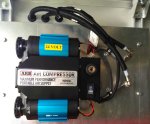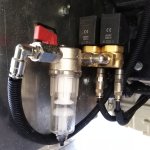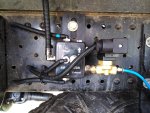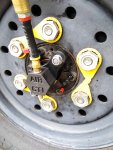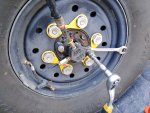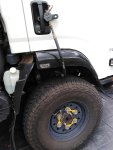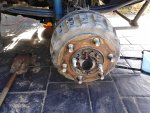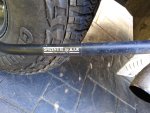Ultimark
Active member
Over the decades I’ve been travelling to various parts of our continent, and sometimes places overseas where one travels on dirt and muddy roads, not to mention sand, snow and other obstacles which has often meant that one compromises on the correct tyre pressure for the terrain, load and speed. For quite some time I have, like virtually everyone else, managed to adjust tyre pressures by stopping and airing down, then airing up with a portable compressor.
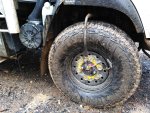
I first I did this on motorcycles using a hand pump, which worked well, except when requiring pumping up in hot weather. One day I acquired a very small lightweight 12V pump for the motorcycle, by and large it worked; but it was slow.
Entering the four wheeled type of vehicle for travelling, I needed to up the compressor situation, pickings were slim, but they did manage the job. Another couple of decades and one had a 4x4 ute and a 12V portable compressor; this was heaven. But it still took quite some time to air down and air up, with the time taken to do this sometimes meaning that instead of airing down, one simply slowed right down for the 10-25km or so of dirt sections and felt the bumps quite a lot.
Military vehicles were pretty much the first to have a CTIS fitted to aid in traversing hard surfaces then to seamlessly switch to a different pressure for soft surfaces without requiring the driver to stop and air down. In a military sense having the vehicle stop to do this is not a good idea, so their usage was (I’m supposing) mainly driven by keeping their vehicle and driver(s) functional and alive.
Many people have heard of the German Unimog vehicle, which has as an extra, their own inbuilt CTIS. I’m not sure about early units, but their current offerings are linked directly to the vehicles computer system and will override if too low a setting has been set and the vehicle speed is increased by the operator over the tyre inflation parameters. MAN trucks also have a CTIS system as an option, but I’m not too sure if it is theirs or something they procure and build into their trucks. In Australia, as far as I know, these are the only two mainstream trucks that have a CTIS available ex-factory. For the rest of us, anything like this is an aftermarket possibility, albeit, a limited aftermarket possibility.
Large trucks run air brakes and therefore have a ready supply of compressed air which may be tapped and used for airing up tyres. Our truck, a January 2020 build Isuzu NPS 75-155 4x4 is a Light Rigid vehicle, which is any vehicle that has a GVM between 4.5 tonne and 8 tonne and only two axles in the Australian market. Our particular vehicle has a design build of 7.5 tonne and runs hydraulically operated drum brakes all round; I needed a compressor.
A few options are around with possibly the best option being a belt driven compressor driven straight from the engine; combine this with a tank and one is looking good. The belt driven compressor is fast, really fast, but the cost and modifications required along with COVID-19 everywhere and with the world shut down, it was not going to happen. Very expensive portable electrically powered heat pump style compressors were next on the list and except for non-availability due to COVID, I would have procured one.
I looked at ARB twin cylinder compressors, they were in short supply but ARB had something that would fit the bill, their 24V twin cylinder air compressor was in stock, complete with a tank in a portable carry case. Our truck has a 24V electrical system and for once, procuring an electrically driven accessory was easy. According to ARB their 24V twin cylinder air compressor has a 100% duty cycle and it certainly does a pretty good job of airing up the largish truck tyres.
This air compressor was used to manually air up the tyres for almost a year before we acquired our CTIS. Depending upon how low we had gone down, or how high up we were upping the tyre pressure, we could be waiting for about 12-15 minutes; which included unpacking and repacking the compressor stuff.
The decision to acquire a CTIS for the truck was driven by a few parameters. Firstly, the convenience. Secondly, the ability to maintain a constant air pressure, regardless of tyre temperature. Thirdly, the safety factor. An unexpected fourth parameter, was the comfort factor. There are only a few CTIS options available around the world, most of them are targeted to larger trucks and other heavy vehicles which already have an on-board compressor.
I started looking around the world.
Surprisingly, I found a manufacturer of a CTIS only 150km from home in Morwell, Victoria, Australia. AIR CTI is their name and they have been in business since 1999. This family business manufactures their CTIS in-house. One question I had was about the strength of the external hard pipe that is visible and sits outside of the tyres. I was assured that it was as strong as anything and I would be welcome to come to their factory and hammer a piece of their hard pipe on a steel bench with a steel hammer. I never did get to hammer the hard pipe, it got forgotten about in the discussions.
Their hard pipe material, which is the rigid part that is quite visible, is sourced in Australia and bent and manufactured at their factory. After doing some quite tight 4WD tracks that really hadn’t seen much use due to COVID and were therefore quite overgrown, the scariest part was listening to the vegetation make train tracks down each side of the truck and watching the hard pipes disappear into the shrubbery.
On the driver’s side we have two 140 litre fuel tanks, they are inboard of the wheels and at the same height as the hard pipes of the CTIS. Those fuel tanks now have some quite decent train lines running horizontally and the hard pipes have zero scratches. So for stuff that rubs really hard on the hard pipes, that hasn’t be an issue.
If something hooks the pipe that would be another issue. To that end AIR CTI gave us a length of spare soft pipe, which is the small section that connects the hard pipe to the rotator. The rotator is the small plastic bit in the very centre of the wheel which stays stationary while the wheel rotates. It maintains the air seal between the stationary part of the system and the rotating part. The design life of the rotator and its seals is 1,000,000 kilometres.
Their main market is trucks, but they also make a version for a normal car or ute based 4x4 vehicle or standard 2WD vehicle. From what I could physically see when walking around their facility, we could have one of their CTIS fitted to our bog standard Hyundai i30.

I first I did this on motorcycles using a hand pump, which worked well, except when requiring pumping up in hot weather. One day I acquired a very small lightweight 12V pump for the motorcycle, by and large it worked; but it was slow.
Entering the four wheeled type of vehicle for travelling, I needed to up the compressor situation, pickings were slim, but they did manage the job. Another couple of decades and one had a 4x4 ute and a 12V portable compressor; this was heaven. But it still took quite some time to air down and air up, with the time taken to do this sometimes meaning that instead of airing down, one simply slowed right down for the 10-25km or so of dirt sections and felt the bumps quite a lot.
Military vehicles were pretty much the first to have a CTIS fitted to aid in traversing hard surfaces then to seamlessly switch to a different pressure for soft surfaces without requiring the driver to stop and air down. In a military sense having the vehicle stop to do this is not a good idea, so their usage was (I’m supposing) mainly driven by keeping their vehicle and driver(s) functional and alive.
Many people have heard of the German Unimog vehicle, which has as an extra, their own inbuilt CTIS. I’m not sure about early units, but their current offerings are linked directly to the vehicles computer system and will override if too low a setting has been set and the vehicle speed is increased by the operator over the tyre inflation parameters. MAN trucks also have a CTIS system as an option, but I’m not too sure if it is theirs or something they procure and build into their trucks. In Australia, as far as I know, these are the only two mainstream trucks that have a CTIS available ex-factory. For the rest of us, anything like this is an aftermarket possibility, albeit, a limited aftermarket possibility.
Large trucks run air brakes and therefore have a ready supply of compressed air which may be tapped and used for airing up tyres. Our truck, a January 2020 build Isuzu NPS 75-155 4x4 is a Light Rigid vehicle, which is any vehicle that has a GVM between 4.5 tonne and 8 tonne and only two axles in the Australian market. Our particular vehicle has a design build of 7.5 tonne and runs hydraulically operated drum brakes all round; I needed a compressor.
A few options are around with possibly the best option being a belt driven compressor driven straight from the engine; combine this with a tank and one is looking good. The belt driven compressor is fast, really fast, but the cost and modifications required along with COVID-19 everywhere and with the world shut down, it was not going to happen. Very expensive portable electrically powered heat pump style compressors were next on the list and except for non-availability due to COVID, I would have procured one.
I looked at ARB twin cylinder compressors, they were in short supply but ARB had something that would fit the bill, their 24V twin cylinder air compressor was in stock, complete with a tank in a portable carry case. Our truck has a 24V electrical system and for once, procuring an electrically driven accessory was easy. According to ARB their 24V twin cylinder air compressor has a 100% duty cycle and it certainly does a pretty good job of airing up the largish truck tyres.
This air compressor was used to manually air up the tyres for almost a year before we acquired our CTIS. Depending upon how low we had gone down, or how high up we were upping the tyre pressure, we could be waiting for about 12-15 minutes; which included unpacking and repacking the compressor stuff.
The decision to acquire a CTIS for the truck was driven by a few parameters. Firstly, the convenience. Secondly, the ability to maintain a constant air pressure, regardless of tyre temperature. Thirdly, the safety factor. An unexpected fourth parameter, was the comfort factor. There are only a few CTIS options available around the world, most of them are targeted to larger trucks and other heavy vehicles which already have an on-board compressor.
I started looking around the world.
Surprisingly, I found a manufacturer of a CTIS only 150km from home in Morwell, Victoria, Australia. AIR CTI is their name and they have been in business since 1999. This family business manufactures their CTIS in-house. One question I had was about the strength of the external hard pipe that is visible and sits outside of the tyres. I was assured that it was as strong as anything and I would be welcome to come to their factory and hammer a piece of their hard pipe on a steel bench with a steel hammer. I never did get to hammer the hard pipe, it got forgotten about in the discussions.
Their hard pipe material, which is the rigid part that is quite visible, is sourced in Australia and bent and manufactured at their factory. After doing some quite tight 4WD tracks that really hadn’t seen much use due to COVID and were therefore quite overgrown, the scariest part was listening to the vegetation make train tracks down each side of the truck and watching the hard pipes disappear into the shrubbery.
On the driver’s side we have two 140 litre fuel tanks, they are inboard of the wheels and at the same height as the hard pipes of the CTIS. Those fuel tanks now have some quite decent train lines running horizontally and the hard pipes have zero scratches. So for stuff that rubs really hard on the hard pipes, that hasn’t be an issue.
If something hooks the pipe that would be another issue. To that end AIR CTI gave us a length of spare soft pipe, which is the small section that connects the hard pipe to the rotator. The rotator is the small plastic bit in the very centre of the wheel which stays stationary while the wheel rotates. It maintains the air seal between the stationary part of the system and the rotating part. The design life of the rotator and its seals is 1,000,000 kilometres.
Their main market is trucks, but they also make a version for a normal car or ute based 4x4 vehicle or standard 2WD vehicle. From what I could physically see when walking around their facility, we could have one of their CTIS fitted to our bog standard Hyundai i30.
Attachments
-
 CTI_009_IMG_20220122_105650.jpg474 KB · Views: 53
CTI_009_IMG_20220122_105650.jpg474 KB · Views: 53 -
 CTI_008_IMG_20220121_174023.jpg550.2 KB · Views: 48
CTI_008_IMG_20220121_174023.jpg550.2 KB · Views: 48 -
 CTI_007_IMG_20220121_174156.jpg990.1 KB · Views: 38
CTI_007_IMG_20220121_174156.jpg990.1 KB · Views: 38 -
 CTI_001_IMG_20220112_114846.jpg668 KB · Views: 41
CTI_001_IMG_20220112_114846.jpg668 KB · Views: 41 -
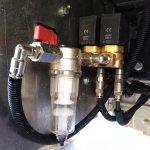 CTI_006_IMG_20220121_174212.jpg656.4 KB · Views: 44
CTI_006_IMG_20220121_174212.jpg656.4 KB · Views: 44 -
 CTI_002_IMG_20220112_114107.jpg994.9 KB · Views: 50
CTI_002_IMG_20220112_114107.jpg994.9 KB · Views: 50


